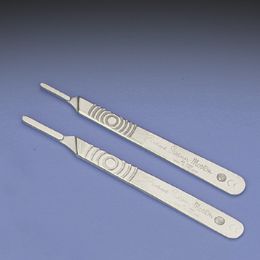










What is a Scalpel?
A scalpel is a small, thin and extremely sharp knife most widely known for its use in surgery, but there are also styles that can be used for crafts and hobbies. This icon of the surgical industry is a very useful tool inside and outside the operating room. A basic craft knife-scalpel can be a handy item to have around the house for various projects.
There are two parts to a scalpel, a blade and a handle. Reusable handles, in the case of a surgical scalpel, are designed to be sterilized. The blade is disposable since it can be removed. With a surgical scalpel, the blade is changed between patients. This is done to ensure that the blade is as sharp as possible for each new patient, and to reduce the risk of transmitting disease and infection. With craft scalpels, the blade is replaced when it becomes less effective and starts to become dull.
Some blades are made to be sharpened and used again. Sharpening a blade can be tricky, because it is so thin, fine, and delicate. It is easy to damage the blade and create a burr which cannot be taken off. Sharpening surgical scalpels can also cause hairline cracks in the surface which can become home to undesirable organisms.
An entire scalpel can be available as a disposable unit. In this type, the handle is often made from plastic and the blade may or may not be retractable. If retractable, the blade stays covered until it is needed to be used and then goes back into the handle for disposal after use.
Craft or surgical, all blades should be disposed of safely. If blades are disposed of uncovered, they could hurt someone since they are very sharp. A sharps container is used in hospitals to hold used scalpels and blades. Craft blades should be secured or wrapped before being thrown away so trash personnel do not get cut when handling the garbage. Some replacement blade sets come in a small box to allow used blades to be placed into the bottom and fresh blades to be taken from the top. The whole box is used as a sharps container for disposal once it is filled with dull, used blades.
What are Different Types of Surgical Scalpels?
Surgical scalpels come in a wide range of different shapes and sizes. Surgical scalpels, in general, are designed individually for specific types of surgery. For example, a scalpel with a rounded No. 10 blade is normally used to make incisions on the skin. A No. 7 blade would be used for a more delicate, precise incision for an internal surgery. To help precisely measure an incision, some types have rulers on the handles.
All surgical scalpels can be grouped into two main categories, disposable and reusable. Reusable scalpels often have a disposable blade attached to a reusable handle, and the blades are discarded after each use. Disposable surgical scalpels are normally a single piece, with plastic handles and retractable blades. After just one use, the entire scalpel is thrown away.
What are Different Types of Scalpel Handles?
Scalpel handles are normally constructed of stainless steel or plastic. They vary in length, but are generally around 5 inches long. Some have tiny screws that must be removed to replace the blade, and other have a snap on feature for securing the blade to eliminate the need for screws.
Surgical handles are commonly identified by a number and are designed to fit a specific hand hold. For example, handle No. 7 is shaped like a pen and is made for close, precise cuts; it is also known as the beaver style handle. Other handles, such as handle No. 4, are flatter and wider. Handle No. 3, called the Bard Parker style, is a common type and has a metric ruler to measure precise cuts. Another common type of handle which is designed for curved incisions is the rounded Siegel style.
If there is a requirement for the use of scalpels for a school science lab, stainless steel handles and replacement blades are more cost effective in the long run. This is because students tend to break a lot of blades, and blades are cheaper to replace than disposable scalpels. Stainless steel handles are also more durable and easier to clean than plastic handles and will likely last longer. Busy teachers who need to replace broken blades quickly may like the snap on blades as opposed to the type that require screws.
What are Different Types of Scalpel Blades?
There are many types of scalpel blades, including stainless steel, disposable, and reusable. Other types of blades include obsidian and retractable, and each have qualities that make them distinctive. Stainless steel blades are most commonly used in operating rooms and are constructed for extreme durability. Retractable blades have a button to allow the surgeon to lock or release the blade as needed for safety. This type can be disposable or reusable.
Obsidian blades are reusable and require occasional sharpening. This blade has a sharper, more precise cutting edge, and ensures less scarring when used during surgery. Micro-dissection blades are normally used for procedures that require dissection of microscopic objects. This type is extremely sharp, precision made, and durable. Generally, stainless steel is the metal that is preferred in this type of blade.
Blade types are identified by a number and come in all shapes and sizes. Most of them have a triangular or a crescent shape. Many types are basically smaller or larger versions of commonly used blades. Each type’s shape is made for its primary use. For example, blade No. 11 has a pointed end and is usually used to make stab incisions for drainage purposes. Even though most blades have a single sharp edge, double edged blades called lancets also exist.
Hulet Smith, OT
Rehabmart Co-Founder & CEO
lb